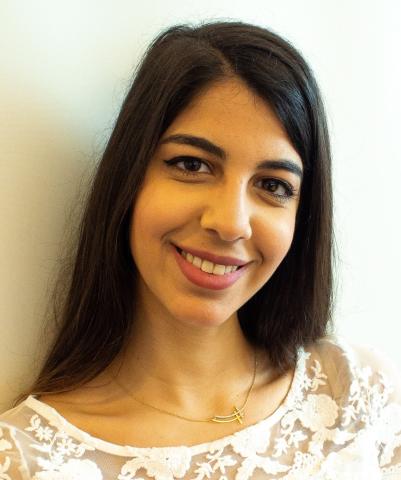ECE Ph.D. student Aline Eid won two top honors at the 2021 IEEE International Symposium on Antennas and Propagation and USNC-URSI Radio Science Meeting (APS/URSI 2021). APS/URSI 2021 was held December 4-10, both in a virtual format and in-person in Singapore at Marina Bay Sands.
Aline Eid won two top honors at the 2021 IEEE International Symposium on Antennas and Propagation and USNC-URSI Radio Science Meeting (APS/URSI 2021), held December 4 both in a virtual format and in-person in Singapore at Marina Bay Sands. Eid is a Ph.D. student in the Georgia Tech School of Electrical and Computer Engineering (ECE).
Eid received the Best Student Paper Award at APS/URSI 2021. She also received the Mojgan Daneshmand Grant, awarded to only six women across six continents, with Eid representing North America. She is a member of the ATHENA Research Group, which is led by Manos Tentzeris, the Ken Byers Professor in Flexible Electronics in the School of ECE.
The title of Eid’s award-winning paper is "UHF Tags Array for Holographic Target Localization and Wireless Health Monitoring.” Her co-authors are Tentzeris; Jimmy Hester, a Ph.D. alumnus of the ATHENA Research Group who now works with Atheraxon, Inc.; Luzhou Xu of Google, LLC; and Jinan Zhu, who worked with Google at the time of submission, but who is now with Facebook Reality Labs.
This paper represents work that Eid did while on an internship that was conducted remotely with the Mountain View, California location of Google from June-December 2020. The work described in this paper uses an array of low-cost batteryless stickers (RFID tags) to create a hologram of a patient sitting in a room.
The team combined beamforming techniques with holography to construct the image of targets and gathered information about their location and vital signs. Using this technology, a patient's vital signs can be wirelessly monitored as he or she waits in the emergency ward and can be sent to the staff to assess the urgency of the patient’s visit and to provide useful information prior to examination.
Eid was also awarded the Mojgan Daneshmand Grant, which recognizes the achievements of women engineers in master’s and doctoral programs and in industry. She was recognized for developing unconventional printed structures to enable batteryless devices with breakthrough wireless capabilities by combining knowledge in electromagnetics, antennas, RFIDs, signal processing, and materials science.
Some of Eid’s key achievements, done in collaboration with her colleagues, that led to her receiving this grant include:
- Development of the first 5G/mm-wave printed, flexible structure capable of harvesting mm-wave energy with high gain and wide angular coverage and promising to power Internet of Things (IoT) devices at 100+m range. This work, published in Scientific Reports, Nature, reached 110,000 reads in less than one year, received six awards (including five from the Microwave Engineering Society), and was featured in more than 40 news outlets.
- Development of a low-power backscattering communication RFID tag, capable of communicating at km-ranges while fully-powered by a compact flexible solar cell. This work was published in the IEEE Antennas and Wireless Propagation Letters (AWPL) and used the same passive beamforming network—the Rotman lens—used in the previous work.
- Development of the first fully-tunnel diodes-based, fully-passive backscattering RFID tag. The tag features an ultra-long communications range while requiring a very low voltage (88 mV) and power consumption (20 μW). This work was published in the 2020 IEEE/MTT-S International Microwave Symposium (IMS).
- Development of the first holography-based contactless health monitoring and target localization technique based on UHF tags arrays. The work was published in the IEEE Internet of Things Journal and received the best paper award in the 2021 IEEE International Symposium on Antennas and Propagation (APS), as described in the first part of this article.
